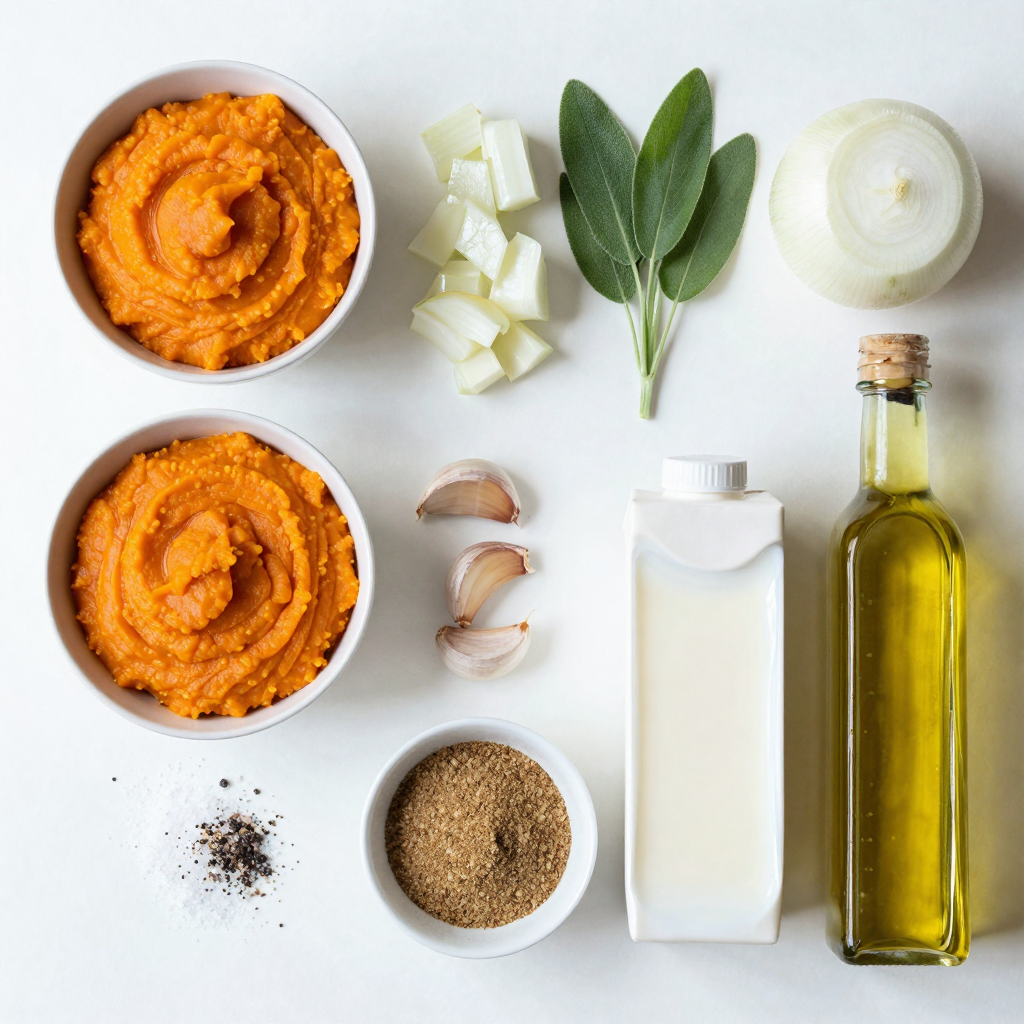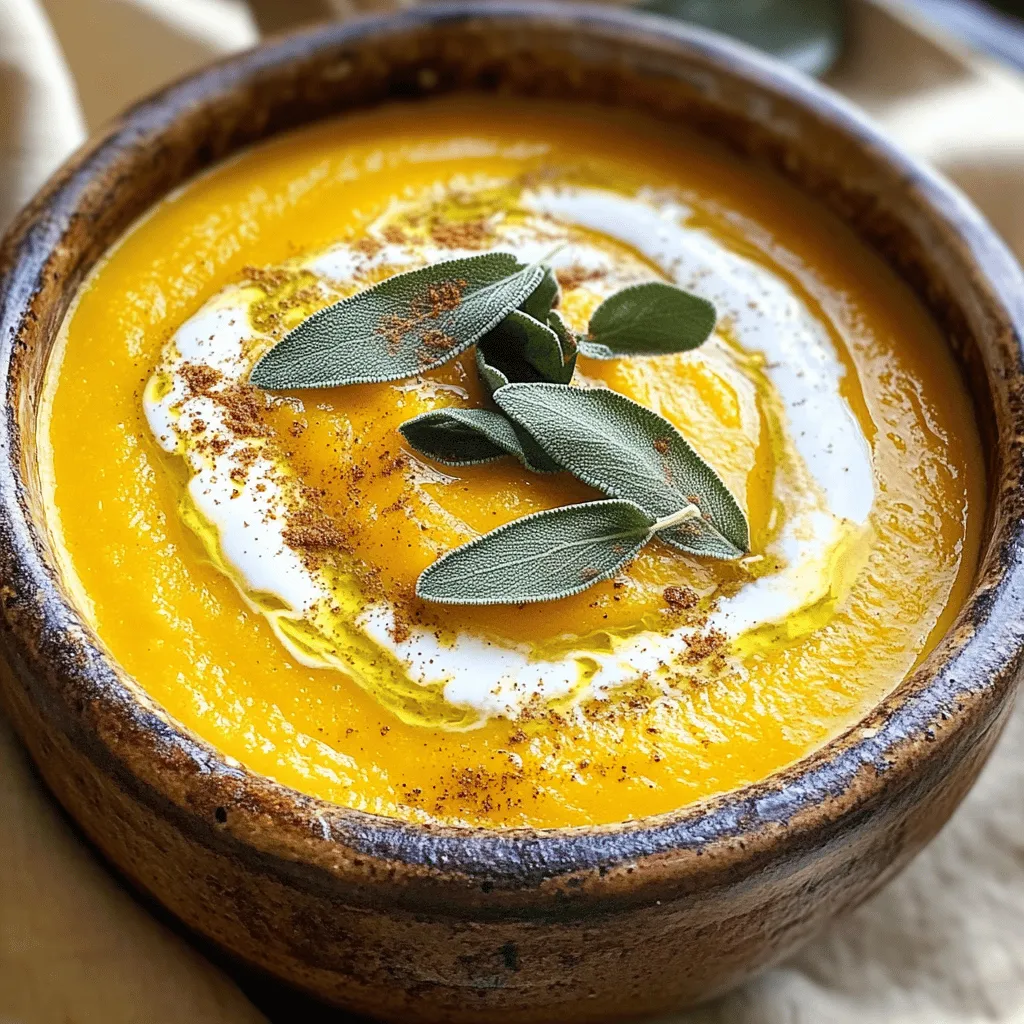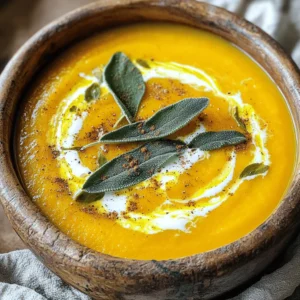Roasted Pumpkin Sage Soup Creamy and Comforting Meal

Are you ready to warm your soul with a bowl of Roasted Pumpkin Sage Soup? This creamy and comforting meal is perfect for cozy nights and chilly days. With simple steps and a few key ingredients, you’ll create a dish that satisfies both your taste buds and your stomach. Join me as we explore how to make this delicious soup that’s sure to impress your family and friends!
Why I Love This Recipe
- Comforting Flavor: This roasted pumpkin sage soup has a warm, cozy taste that is perfect for chilly days.
- Easy Preparation: With just a few simple steps, you can create a delicious and hearty soup that impresses.
- Healthy Ingredients: Pumpkin and coconut milk provide a nutritious base, making this soup both tasty and wholesome.
- Versatile Serving: This soup can be served as an appetizer or a main dish, perfect for any occasion.
Ingredients
Essential Ingredients for Roasted Pumpkin Sage Soup
To make this soup, you need a few key ingredients:
- 2 cups pumpkin puree (freshly roasted or canned)
- 1 medium onion, diced
- 3 cloves garlic, minced
- 2 tablespoons fresh sage, chopped (plus extra leaves for garnish)
- 4 cups vegetable broth
- 1 cup coconut milk
- 2 tablespoons olive oil
- 1 teaspoon ground cumin
- Salt and pepper to taste
- Optional: a pinch of nutmeg or cinnamon for warmth
These ingredients create a rich and tasty soup. The pumpkin gives it a smooth texture. The sage adds a lovely herbal note.
Recommended Type of Pumpkin
I recommend using sugar pumpkins or pie pumpkins for this soup. These pumpkins are sweeter and have a smooth flesh. They roast well and blend nicely. Avoid using large carving pumpkins; they are watery and bland. Freshly roasted pumpkin adds depth. If you choose canned pumpkin, make sure it’s pure pumpkin, not pie filling.
Additional Seasoning and Flavor Options
You can play with the flavors of this soup. Try adding a pinch of nutmeg or cinnamon for warmth. These spices enhance the sweetness of the pumpkin. You can also add a dash of cayenne pepper for a little heat. If you love a savory kick, try adding a splash of soy sauce or miso. Each option gives a unique twist to the soup. Enjoy experimenting with flavors!

Step-by-Step Instructions
Prepping Your Pumpkin
Start by preheating your oven to 400°F (200°C). Cut your pumpkin in half and scoop out the seeds. Brush the insides lightly with olive oil. Sprinkle some salt on top for flavor. Place the pumpkin cut-side down on a baking sheet. Roast it in the oven for 30 to 40 minutes until it’s soft. Once done, let it cool a bit before scooping out the flesh.
Cooking the Base for the Soup
In a large pot, heat two tablespoons of olive oil over medium heat. Add the diced onion and sauté for about five minutes. You want the onion to look clear, not brown. Next, stir in three minced garlic cloves and two tablespoons of chopped sage. Let this cook for two minutes until it smells amazing. Once your pumpkin is ready, scoop out the flesh and add it to the pot. Pour in four cups of vegetable broth and bring it to a gentle boil. After that, lower the heat and let it simmer for 15 minutes.
Blending and Finalizing the Soup
Now comes the fun part! Use an immersion blender to blend the soup until it’s smooth. If you’re using a regular blender, be careful with the hot liquid. Blend in batches if needed. After blending, stir in one cup of coconut milk and one teaspoon of ground cumin. Add salt and pepper to taste. If you like, you can sprinkle in a pinch of nutmeg or cinnamon for extra warmth. Heat the soup for another five minutes, and it’s ready to serve! Enjoy it warm with fresh sage leaves and a drizzle of coconut milk on top.
Pro Tips
- Fresh Sage Flavor: Use fresh sage instead of dried for a more vibrant and aromatic flavor in your soup.
- Coconut Milk Creaminess: For an extra creamy texture, use full-fat coconut milk and blend it well into the soup.
- Roasting Pumpkin: Roasting your pumpkin until caramelized adds a deeper flavor profile compared to boiling or steaming.
- Seasoning Balance: Taste and adjust your seasoning at the end; sometimes a little more salt or a pinch of sugar can enhance sweetness.
Tips & Tricks
How to Perfect the Texture of Your Soup
To get a creamy texture, blend your soup well. I use an immersion blender, but a regular blender works too. Just be careful with hot soup. If the soup feels too thick, add more vegetable broth. If it’s too thin, simmer it longer to thicken. This will make it nice and smooth.
Enhancing Flavor with Seasoning Adjustments
Taste is key. I always try my soup before serving. If it needs more flavor, add salt and pepper. A pinch of nutmeg or cinnamon adds warmth and depth. You can also add a splash of lemon juice for brightness. Fresh sage really shines in this soup. So, don’t skip the garnish!
Serving Suggestions for Roasted Pumpkin Sage Soup
Serve your soup in rustic bowls. A swirl of coconut milk on top looks beautiful. Add crispy sage leaves for a crunchy contrast. This soup pairs well with warm bread or a fresh salad. It’s perfect for cozy dinners or gatherings. Enjoy it with loved ones for the best experience.

Variations
Vegan Alternatives for Creaminess
If you want a vegan soup, coconut milk is a great choice. It adds rich creaminess without dairy. You can also try cashew cream for a different texture. Blend soaked cashews with water until smooth. This option gives you a nutty flavor and nice creaminess.
Adding Protein to the Recipe
To make your soup heartier, add protein. Cooked lentils or chickpeas work well. They blend nicely and keep the soup smooth. You can also add tofu for a soft texture. Simply cube and stir it in before blending. This will make the soup filling and nutritious.
Flavor Variations with Different Herbs
Sage shines in this recipe, but you can try other herbs too. Thyme adds a lovely earthiness. Rosemary can bring a strong flavor that pairs well with pumpkin. For a fresh twist, add cilantro or parsley just before serving. Experimenting with herbs lets you find your favorite blend.
Storage Info
Best Practices for Storing Leftovers
After enjoying your delicious roasted pumpkin sage soup, store leftovers in an airtight container. Let the soup cool to room temperature before sealing. This keeps flavors fresh and prevents bacteria growth. Place the container in the refrigerator. The soup will stay tasty for about 3 to 5 days. If you want to keep it longer, consider freezing it.
Reheating Instructions for Optimal Taste
To reheat your soup, pour it into a pot over medium heat. Stir often to warm it evenly. This helps maintain the creamy texture. You can also use a microwave. Heat in 30-second intervals, stirring in between. Be cautious, as the soup can get hot quickly. Taste and adjust seasoning if needed. Add a splash of coconut milk for extra creaminess.
Freezing Roasted Pumpkin Sage Soup
Freezing is a great way to save your soup for later. First, let it cool completely. Then, pour the soup into freezer-safe bags or containers. Leave some space at the top, as liquids expand when frozen. Label with the date and contents. It can last up to 3 months in the freezer. To thaw, place the soup in the fridge overnight before reheating. Enjoy a warm bowl any time!
FAQs
Can I use canned pumpkin instead of fresh?
Yes, you can use canned pumpkin. It saves time and still tastes great. Just make sure to choose pure pumpkin puree, not pumpkin pie filling. This swap can make your soup creamy and delicious.
How long will the soup last in the refrigerator?
The soup can last up to five days in the fridge. Store it in an airtight container to keep it fresh. Before serving, reheat it on the stove to enjoy its full flavor.
What to serve with Roasted Pumpkin Sage Soup?
This soup pairs well with crusty bread or a simple salad. You can also serve it with grilled cheese sandwiches for a cozy meal. These sides add nice texture and balance to the soup.
How can I adjust the spice level of the soup?
To adjust the spice level, add more or less ground cumin. If you like heat, add a pinch of red pepper flakes or cayenne pepper. Start with a small amount and taste as you go. This way, you can find the flavor you love.
This article covered how to make delicious roasted pumpkin sage soup. We explored essential ingredients and step-by-step instructions to prepare it perfectly. Remember to adjust flavors and textures to suit your taste. You can even try variations like vegan options or adding protein. Proper storage and reheating will keep your soup fresh and tasty. Now, it’s time for you to enjoy this warm dish, whether on a chilly day or for a cozy meal. Happy cooking!

Roasted Pumpkin Sage Soup
Ingredients
2 cups pumpkin puree (freshly roasted or canned)
1 medium onion, diced
3 cloves garlic, minced
2 tablespoons fresh sage, chopped (plus extra leaves for garnish)
4 cups vegetable broth
1 cup coconut milk
2 tablespoons olive oil
1 teaspoon ground cumin
Salt and pepper to taste
Optional: a pinch of nutmeg or cinnamon for warmth
Instructions
Preheat your oven to 400°F (200°C).
Cut the pumpkin in half and remove the seeds. Lightly brush the inside with olive oil, sprinkle with salt, and place cut-side down on a baking sheet. Roast for 30-40 minutes until tender.
In a large pot, heat olive oil over medium heat. Add the diced onion and sauté for about 5 minutes until translucent.
Stir in the minced garlic and chopped sage, cooking for an additional 2 minutes until fragrant.
Once the pumpkin is roasted, scoop out the flesh and add it to the pot with the sautéed onions and garlic.
Pour in the vegetable broth and bring the mixture to a gentle boil. Reduce the heat and let it simmer for 15 minutes.
Using an immersion blender, blend the soup until smooth. If using a regular blender, blend in batches, being cautious with the hot liquid.
Stir in the coconut milk and cumin, and season with salt, pepper, and optional spices to taste. Heat the soup through for another 5 minutes.
Serve warm, garnished with fresh sage leaves and a drizzle of coconut milk if desired.
Prep Time, Total Time, Servings: 15 min | 60 min | 4 servings
– Presentation Tips: Serve the soup in rustic bowls, garnished with a swirl of coconut milk and crispy sage leaves on top for an elegant touch.

Roasted Pumpkin Sage Soup
Ingredients
- 2 cups pumpkin puree (freshly roasted or canned)
- 1 medium onion, diced
- 3 cloves garlic, minced
- 2 tablespoons fresh sage, chopped (plus extra leaves for garnish)
- 4 cups vegetable broth
- 1 cup coconut milk
- 2 tablespoons olive oil
- 1 teaspoon ground cumin
- to taste salt and pepper
- a pinch nutmeg or cinnamon (optional)
Instructions
- Preheat your oven to 400°F (200°C).
- Cut the pumpkin in half and remove the seeds. Lightly brush the inside with olive oil, sprinkle with salt, and place cut-side down on a baking sheet. Roast for 30-40 minutes until tender.
- In a large pot, heat olive oil over medium heat. Add the diced onion and sauté for about 5 minutes until translucent.
- Stir in the minced garlic and chopped sage, cooking for an additional 2 minutes until fragrant.
- Once the pumpkin is roasted, scoop out the flesh and add it to the pot with the sautéed onions and garlic.
- Pour in the vegetable broth and bring the mixture to a gentle boil. Reduce the heat and let it simmer for 15 minutes.
- Using an immersion blender, blend the soup until smooth. If using a regular blender, blend in batches, being cautious with the hot liquid.
- Stir in the coconut milk and cumin, and season with salt, pepper, and optional spices to taste. Heat the soup through for another 5 minutes.
- Serve warm, garnished with fresh sage leaves and a drizzle of coconut milk if desired.



![To make Easy Chicken and Dumplings, gather these key ingredients: - 1 lb (450g) boneless chicken thighs, diced - 4 cups chicken broth - 1 medium onion, chopped - 2 cloves garlic, minced - 2 cups carrots, sliced - 1 cup celery, chopped - 1 tsp dried thyme - 1 tsp dried rosemary - Salt and pepper to taste - 1 cup all-purpose flour - 2 tsp baking powder - 1/2 tsp salt - 1/2 cup milk - 2 tbsp butter, melted - Fresh parsley, chopped (for garnish) These ingredients combine to create a warm and filling dish. The chicken provides protein, while the veggies add flavor and color. The broth forms a rich base, and the dumplings offer a fluffy texture. You can add your own twist to this dish with these optional ingredients: - Frozen peas for extra sweetness - Corn for a pop of color - Different herbs like oregano or basil - A splash of cream for a richer broth Feel free to mix and match these to suit your taste. Personalizing your dish can make it even more special. To make this recipe, you will need: - A large pot for cooking - A cutting board and knife for chopping - A mixing bowl for the dough - A whisk for mixing dry ingredients - A spoon for dropping dumplings Using the right tools keeps your cooking smooth and easy. Having everything ready helps you enjoy the process more. For the full recipe, check out the detailed instructions that follow! Start by heating a bit of olive oil in a large pot over medium heat. Add 1 lb of diced boneless chicken thighs. Sauté the chicken until it turns golden brown, which takes about 5 to 7 minutes. Once done, remove the chicken and set it aside. In the same pot, toss in 1 medium chopped onion, 2 minced garlic cloves, 2 cups of sliced carrots, and 1 cup of chopped celery. Sauté these veggies for 5 to 6 minutes, until they soften. This step builds a great flavor base. In a mixing bowl, combine 1 cup of all-purpose flour, 2 teaspoons of baking powder, and 1/2 teaspoon of salt. Mix well. Create a well in the center of the dry mix. Pour in 1/2 cup of milk and 2 tablespoons of melted butter. Stir until the mixture just combines into a dough. Be careful not to overmix; it should remain a bit lumpy for fluffy dumplings. Return the cooked chicken to the pot with the sautéed veggies. Pour in 4 cups of chicken broth and add 1 teaspoon each of dried thyme and dried rosemary. Season with salt and pepper to your taste. Bring this mixture to a gentle simmer. Once simmering, drop spoonfuls of the dumpling dough into the pot. Cover the pot with a lid and let the dumplings cook for about 15 to 20 minutes. This steaming process makes them rise and become fluffy. After cooking, taste and adjust the seasoning if needed. Serve hot, garnished with fresh parsley for a touch of color. For the full recipe, check [Full Recipe]. To make fluffy dumplings, use the right ratio of flour and liquid. The dough should be soft, not too dry or runny. Mix gently; over-mixing leads to tough dumplings. Drop spoonfuls of the dough onto the simmering broth. Cover the pot and let them steam. This helps them rise and stay fluffy. One common mistake is cooking the dumplings uncovered. This can make them dense. Another mistake is using old baking powder. Always check the expiration date for the best rise. Be careful not to stir the dumplings while they cook. Agitation can break them apart and ruin their fluffy texture. To make your dish pop, add fresh herbs like parsley or thyme at the end. A squeeze of lemon juice brightens the flavors. For deeper flavor, sauté the vegetables longer until they caramelize. You can also add a splash of cream for a richer broth. These tips make your chicken and dumplings even more comforting. For the full recipe, check out the recipe section above. {{image_2}} You can make easy chicken and dumplings even creamier. To do this, add 1 cup of heavy cream or half-and-half to the chicken broth. This change gives the dish a rich texture. You can also use a can of cream of chicken soup. It adds creaminess and flavor with little effort. For a fun twist, try using different types of meat like turkey or even a mix of chicken and sausage. If you want a lighter meal, swap chicken thighs for chicken breasts. This reduces fat and calories. You can also use low-sodium chicken broth. For a gluten-free version, replace all-purpose flour with a gluten-free baking mix. Just be sure to check the mix for baking powder. Lastly, you can add more vegetables like peas or spinach for extra nutrients. You can boost the taste of your chicken and dumplings with spices. Add paprika for a smoky flavor or cayenne for some heat. Fresh herbs like parsley, dill, or chives can brighten the dish. You can mix in a squeeze of lemon juice for a fresh zing. Don’t forget to taste as you go! Adjust the seasoning to make it just right for you. These variations make it easy to customize this dish. You can check the Full Recipe for more ideas and tips! To keep your chicken and dumplings fresh, let them cool first. Use an airtight container for storage. This helps keep moisture in and prevents drying out. Store them in the fridge for up to three days. Label the container with the date to track how long it's been there. When ready to eat your leftovers, use a pot for reheating. Add a splash of broth or water to keep the dish moist. Heat on low to medium heat, stirring gently. This helps prevent the dumplings from breaking apart. You can also use the microwave, but stir halfway through for even heating. You can freeze chicken and dumplings for later. Place them in a freezer-safe container or bag. Remove as much air as possible to prevent freezer burn. They can last up to three months in the freezer. To reheat, thaw overnight in the fridge before warming on the stove. This keeps the texture nice and fluffy. For the full recipe, check the main article. I recommend using boneless chicken thighs for chicken and dumplings. They stay juicy and tender during cooking. Thighs also add rich flavor to the dish. If you prefer, you can use boneless chicken breasts. Just keep in mind that they can dry out more easily. Yes, you can use frozen vegetables! Frozen veggies are a great time-saver. They cook quickly and still add good taste. If using frozen carrots or peas, add them to the pot for the last few minutes of cooking. This way, they stay bright and flavorful. Dumplings need about 15 to 20 minutes to cook. Cover the pot with a lid during this time. This helps them steam and rise properly. You’ll know they are done when they puff up and feel firm to the touch. Enjoy the fluffy goodness! For the full recipe, check out the [Full Recipe]. You have all you need to create easy chicken and dumplings. The key ingredients set a strong base. You can customize flavors with optional ingredients and cool spices. Following the step-by-step process ensures a warm and comforting meal. Remember to learn from tips to avoid mistakes and make your dumplings fluffy. Store any leftovers properly and enjoy them later. This dish can change with simple variations, making it a staple in your kitchen. Now, get cooking and share this delightful meal with family.](https://dailydishlab.com/wp-content/uploads/2025/06/21507376-38c9-4f66-b35b-162bfb5424ce-768x768.webp)


